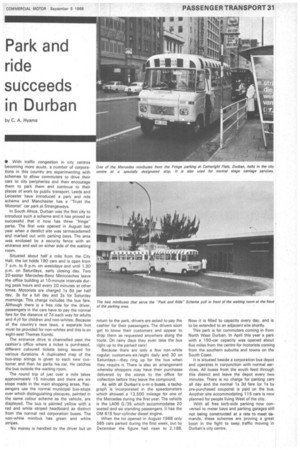Park and ride
Page 33

If you've noticed an error in this article please click here to report it so we can fix it.
succeeds•
in Durban
by C. A. Hyams • With traffic congestion in city centres becoming more acute, a number of corporations in this country are experimenting with schemes to allow commuters to drive their cars to city peripheries and then encourage them to park them and continue to their places of work by public transport. Leeds and Leicester have introduced a park and ride scheme and Manchester has a "Trust the Motorist" car park at Strangeways.
In South Africa, Durban was the first city to introduce such a scheme and it has proved so successful that it now has three "fringe" parks. The first was opened in August last year when a derelict site was tarmacadamed and marked out with parking bays. The area was enclosed by a security fence with an entrance and exit on either side of the waiting room.
Situated about half a mile from the City Hall, the lot holds 190 cars and is open from 7 a.m. to 6 p.m. on weekdays and until 1.30 p.m. on Saturdays. early closing day. Two 20-seater Mercedes-Benz Minicoaches leave the office building at 10-minute intervals during peak hours and every 20 minutes at other times. Motorists are charged Is 6d per half day, 3s for a full day and 2s for Saturday mornings. This charge includes the bus fare. Although there is a free ride for the driver, passengers in the cars have to pay the normal fare for the distance of 7d each way for adults and 40 for children and non-whites. Because of the country's race laws, a separate bus must be provided for non-whites and this is an eight-seat Thames Kombi.
The entrance drive is channelled past the cashier's office where a ticket is purchased, different coloured tickets being issued for various durations. A duplicated map of the bus-stop sitings is given to each new customer and then he parks his car. He catches the bus outside the waiting room.
The round trip of just over a mile takes approximately 15 minutes and there are six stops made in the main shopping areas. Passengers use the normal municipal bus-stops over which distinguishing placques, painted in the same colour scheme as the vehicle, are displayed. The bus is painted yellow with a red and white striped headboard as distinct from the normal red corporation buses. The non-white minibus has green and white stripes.
No money is handled by the driver but on return to the park, drivers are asked to pay the cashier for their passengers. The drivers soon get to know their customers and appear to drop them as requested anywhere along the route. On rainy days they even take the bus right up to the parked cars!
Because there are only a few non-white regular customers-six/eight daily and 30 on Saturdays—they ring up for the bus when they require it. There is also an arrangement whereby shoppers may have their purchases delivered by the stores to the office for collection before they leave the compound.
As with all Durban's o-m-o buses, a tachograph is incorporated in the speedometers which showed a 13,500 mileage for one of the Mercedes during the first year. The vehicle is the L406 G /35 which accommodates 20 seated and six standing passengers. It has the OM 615 four-cylinder diesel engine.
When the lot opened in August 1968 only 585 cars parked during the first week, but by December the figure had risen to 2,168. Now it is filled to capacity every day, and is to be extended to an adjacent site shortly.
This park is tor commuters coming in from North West Durban. In April this year a park with a 150-car capacity was opened about five miles from the centre for motorists coming from the southern suburbs and towns on the South Coast.
It is situated beside a corporation bus depot and operates in conjunction with normal serVices. All buses from the south feed through this district and leave the depot every two minutes. There is no charge for parking cars all day and the normal 1s 3d fare or Is by pre-purchased coupons) is paid on the bus. Another site accommodating 115 cars is now planned for people living West of the city.
With all free kerb-side parking now converted to meter bays and parking garages still not being constructed at a rate to meet demands, these schemes are proving a great boon in the fight to keep traffic moving in Durban's city centre.






















































































































